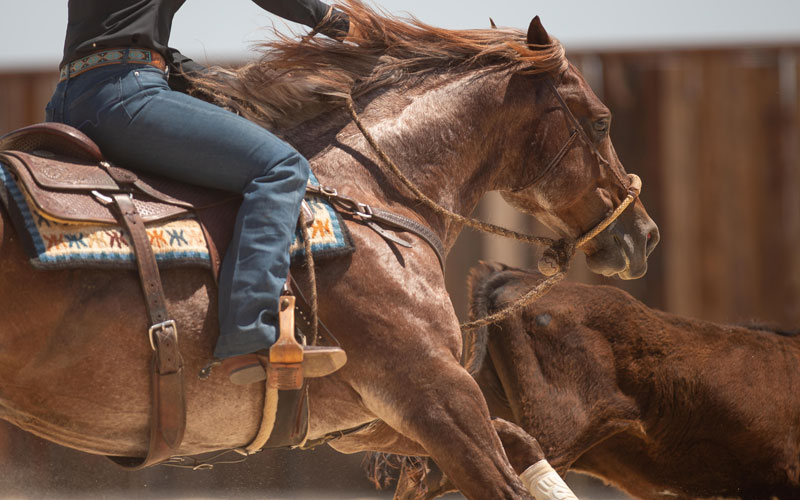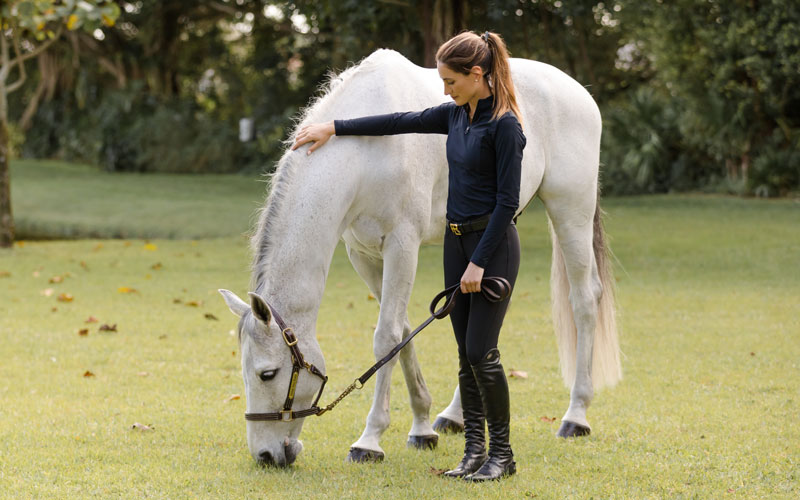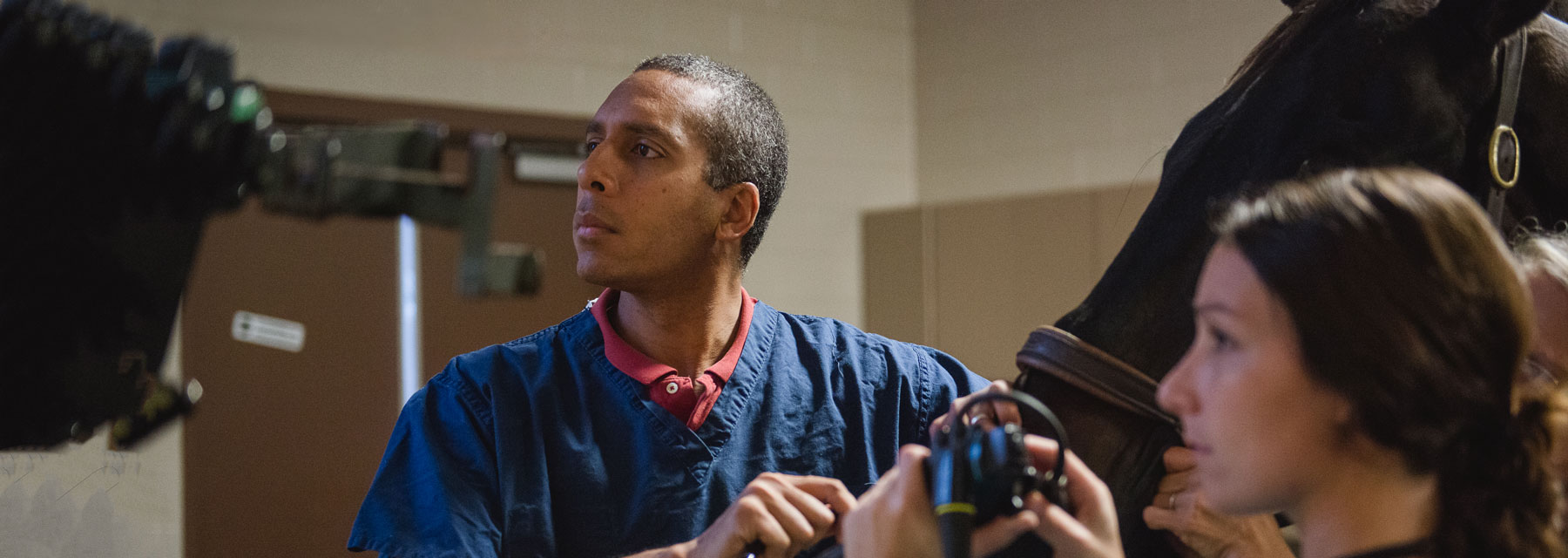Equine Gastric Ulcer Syndrome: Potential causes, treatments, performance implications and preventive measures
At first glance, equine ulcers seem well understood with an established diagnostic process and tried treatment modalities. Beneath the surface, however, it quickly becomes clear that ulcers remain a bit of an enigma, with near endless causes, high recurrence rates and an approach that requires a multifaceted and individualized plan to accomplish a successful outcome.
Ulcers touch an overwhelming percentage of the horse population, making them one of the more prolific struggles faced by both riders and equine veterinarians. According to the American Association of Equine Practitioners (AAEP), up to 90 percent of racehorses and 60 percent of performance horses are afflicted with gastric ulcers, with non-performance horses and foals impacted as well. The progress happening in the understanding, treatment and — perhaps, more importantly — the prevention of equine gastric ulcers is incredible. Veterinary medicine is witnessing significant leaps in areas including the impact of NSAIDS, the critical role of diet, the influence of advanced nutrition and the tie between equine gastric ulcers and the horse’s gut microbiome.
Understanding Equine Gastric Ulcer Syndrome
Equine Gastric Ulcer Syndrome, also known as EGUS, is a broad term used in equine veterinary medicine to describe ulcerative and erosive diseases of the stomach. “The mucosal lining of the stomach consists of two regions, the squamous mucosa, which is the nonfunctional lining of the stomach, as well as the glandular mucosa, which secretes gastric acids (hydrochloric acid), pepsinogen, histamine and bicarbonate. These two linings are separated by a border referred to as the margo plicatus,” explains Rodney Belgrave, DVM, MS, DACVIM, owner of Mid-Atlantic Equine Medical Center in Ringoes, New Jersey. EGUS can be broken down into two distinct classifications, Equine Squamous Gastric Disease (ESGD) and Equine Glandular Gastric Disease (EGGD), with these classifications being based on the affected region of the stomach. “Two forms of ESGD exist,” explains Dr. Belgrave further. “Primary ESGD occurs in the absence of other gastrointestinal abnormalities, while the secondary form occurs in relation to existing gastrointestinal abnormalities such as duodenal and pyloric strictures.”
While a clear grading system exists as a diagnostic tool for squamous ulcers, glandular ulcers have no clear-cut grading system. In the case of glandular ulcers, Dr. Belgrave explains that, “The ulceration is described according to the anatomical location of the glandular mucosa in which they occur.”

Equine Gastric Ulcer Syndrome can cause mild to extreme discomfort, which will inevitably impact a horse’s ability to perform.
PHOTO BY CAROLYN SIMANCIK
Cause and Effect
Perhaps one of the most challenging aspects of equine gastric ulcers is that, much like colic, there is no clear-cut, singular cause. Although Thoroughbred racehorses present with EGUS in significantly higher numbers, there have been no further breeds or ages pinpointed as being at a higher risk. Predisposing factors are wide-ranging and vary from environmental influences, travel, stalling practices, NSAID exposure, diet and competition, to name just a few. What is the one thing that each of these contributing factors have in common? All roads lead to stress. “EGUS is most often a reflection of what we ask of these horses,” says Chad Davis, DVM of Davis Equine Sports Medicine in The Plains, Virginia. “Whether it be from a housing standpoint, a nutrition standpoint or a sports/transportation standpoint, it comes down to how well horses are able to adapt to the multifactorial environmental conditions we put them in.”
Performance Implications
Above all else, EGUS can cause anywhere from mild to extreme discomfort and pain in the horse, resulting in behavioral issues and, inevitably, an impact on their ability to perform as athletes. In some cases, it’s those performance-related changes in a horse that often indicate a potential ulcer issue and cause veterinarians to investigate further. Is a horse simply being irritable or “girthy,” or could there be ulcerations revealing themselves through these behaviors? “A lot of these case presentations can mimic the symptoms of mild to severe colic,” says Clayton Smith, DVM of Brazos Valley Equine Hospital in Navasota, Texas. “Often what we’ll see, especially in these performance horses, is after they eat, they’ll get painful. A lot of times they’ll eat a part of their feed and then lie down, mirroring the symptoms of a mild colic. They may get up and slowly finish their meal, sometimes eating their grain at a slower rate than their hay due to the influx of acid that it causes. This discomfort impacts their performance, and we see these horses often kicking out when their rider puts a leg over them or becoming uncharacteristically temperamental when they’re in the ring. They’re not performing to their abilities because of that gastric pain.”

Clayton Smith, DVM,
Brazos Valley Equine Hospital in Navasota, Texas

Rodney Belgrave, DVM, MS, DACVIM,
Mid-Atlantic Equine Medical Center in Ringoes, New Jersey

Chad Davis, DVM,
Davis Equine Sports Medicine in The Plains, Virginia

Canaan Whitfield, DVM, PhD, DACVS, DACVSMR,
Texas A&M University in College Station, Texas
Diagnostic Tools and Challenges
While there is a long list of behavioral and performance indicators that can point toward the presence of ulcers, equine veterinary medicine relies on a strong set of diagnostic tools, led by gastroscopy, to definitively confirm, then grade ulcers. Dr. Davis is quick to point out that gastroscopy is a necessity when ulcers are suspected to avoid medically treating suspected ulcers when something else entirely could be going on. “For every horse that gets prescribed medication for gastric ulcers without ever taking a look inside their stomach, I always ask myself ‘How do we know if that is a correct treatment? How do we know exactly what condition is going on? When do we stop the medication and what medication would we use?’” Diagnosis is quite literally a guessing game in the absence of gastroscopy. “Gastroscopy allows for a thorough evaluation of the stomach, grading and localization of the ulcers, as well as assessment of the proximal small intestine (duodenum),” confirms Dr. Belgrave.
While gastroscopy gives the veterinarian a window into the horse’s stomach and gastrointestinal tract, properly diagnosing then grading ulcers is still a challenge, especially given their location. “All portions of the stomach need to be investigated,” asserts Dr. Davis. “There are at least three if not four areas in the stomach that we should be looking at. When you break it down, you have that nonglandular stratified squamous mucosa. That’s the top portion of the stomach, which also contains a cardiac sphincter where the scope enters the stomach,” he explains. “You have the region where the nonglandular portion of the stomach and the margo plicatus meet. That’s predominantly where we’ll see various grades of gastric ulcers. Then, there is the glandular mucosa, where acidic pumps are predominantly located and where acid is being produced. A unique aspect of the glandular mucosa is its protective waxy coating that, when broken down, allows for glandular mucosal ulcers and also ulcers in the pyloric region,” explains Dr. Davis. A healthy glandular mucosa in a pylorus has a sheen to it thanks to that protective waxy barrier. This barrier can be damaged by things such as antibiotics and NSAIDs. While veterinarians are performing a gastroscopy, they’re looking closely at these various regions and the integrity of that protective waxy coating.
As the gastroscopy continues, Dr. Davis outlines the next steps. “We’ll pass through the pyloric sphincter in the pyloric antrum into the small intestine. We’ll sometimes take a biopsy of the stomach or the small intestine, and we’ll do that either in the case of a very ill horse or when the stomach looks really inappropriate. This will also happen in a follow up gastroscopy 20 to 35 days following the beginning of treatment.”
When gastroscopy isn’t an option due to cost, a client’s unease at the prospect of fasting their horse or other factors, the diagnostic process turns to other options. “Probably the biggest diagnostic challenge is the inability to accurately diagnose and determine the severity of ulceration without a gastroscopic examination,” says Dr. Belgrave. “With time, the accuracy of tests to diagnose ulceration will improve; however, their ability to determine the degree of ulceration will always be limited. As a result, a stall side test will likely never fully replace the benefits of a thorough gastroscopic examination.” Other diagnostic methods that are used stand-alone or in conjunction with a gastroscopy can include veterinarians pulling blood and running a full CBC and chemistry panel as well as serum amyloid A (SAA) to understand potential infections and the inflammatory component, respectively. A simple fecal test can be an important component to the overall diagnostic picture as well. Lastly, ultrasound provides a noninvasive option that can be easily administered. While not accommodating the level of detail that the gastroscopy can offer, ultrasound can provide valuable imagery, particularly if the veterinarian is looking to confirm or rule out a specific concern.
A Whole-Horse Approach
Veterinary medicine has propelled forward in its approach to not only treating disease, such as EGUS, but in preventing disease. This root-cause approach to patient care has veterinarians no longer treating conditions and injuries as stand-alone ailments, but rather, seeing the horse as an interconnected and synergistically-operating collection of systems. “We’re sport horse veterinarians, but we approach our patients from a functional and integrative medicine perspective,” says Dr. Davis. “The entire horse plays a role in most conditions that we’re addressing, and this demands that we look at the horse from nose to tail and everything in between.”
In the case of EGUS and the stable of pharmaceutical drugs that veterinarians commonly rely on, Dr. Davis sees the benefit of these therapies and uses them frequently while always falling back on a functional and integrative whole-horse approach. “The medications we use to treat EGUS try to alter and control the environment in the stomach so that the equine body can heal those ulcerations on its own.” These therapeutics can include both proton pump inhibitors and H2‐receptor antagonists. “Their job is to quiet that acid production such that the acid cannot insult the mucosa that is trying to heal,” continues Dr. Davis. “When I see a grade 1 gastric ulcer syndrome, I’ll often see a yellow-green coating over the nonglandular portion of the stomach mucosa and that hyperkeratosis is the body’s biological BAND-AID® trying to heal the insult. I see that and think, ‘Well, the horse has obviously been dealing with this for some time and is trying really hard to be able to manage this condition all on its own. What can I do to support what the horse is trying to do?’ I may not have to throw everything at this horse. It may just need a singular component, and that’s where the horse’s history is so important to know, as well as the horse’s diet, workload and how it’s being managed.”
A primary factor to keep in mind is that the horse’s stomach is a naturally-acidic environment with a pH that can range from an acidic 1.5 to a more neutral 7, depending on each horse’s unique chemistry. In the pyloric region the acidity level only goes up, ranging from a pH of 1.5 to 4. “In the case of gastric ulcers when stomach acid becomes too acidic in nature, the question becomes not just how do we treat it, but why is this happening in the first place,” says Dr. Davis of his root-cause approach. “The key is recognizing the stressors for each individual horse and what exactly is causing this issue. Is it the horse’s diet, environment, training schedule or something else?” By simply treating the horse without uncovering the root cause of its ulcerations, the horse could be destined for recurrence and a cyclical use of medications that may not impact the real issue. “What can happen with this approach is that you take a horse that naturally tends to be normally more acidic and repeatedly push it into a more neutral or basic realm for extended periods of time. This scenario can cause an overgrowth of bacteria not only in the stomach but throughout the GI tract,” explains Dr. Davis.
This is particularly important when considering a horse’s unique hindgut fermentation process that plays a pivotal role in nutrient absorption and greatly impacts the horse’s overall health and condition. “If you have the pH wrong, you’re going to get improper fermentation,” says Dr. Davis. “Therefore, the horse’s nutrition is going to fall off. I could be seeing a bacterial overgrowth, and now it’s clear that I’m dealing with gastric ulcers because of these contributing factors. There’s always a trail of bread crumbs. The challenge is unearthing them and piecing them together.”
While the stomach is again the overwhelming focus, it’s important to remember that the small intestine, colon and cecum come into play as well. “You’ve got to take care of the entire GI tract,” says Dr. Davis emphatically. “We use products that are able to offer the horse Saccharomyces c. boulardii and dried Lactobacillus delbrueckii and its vital fermentation products, giving them the support they need in the stomach in particular, as well as with the fermentation component in the hindgut and the cecum specifically.”
A critical component to a whole-horse approach goes well beyond treatment and is seen in its preventive power. This includes a horse’s conditioning program, diet and supplement regimen, behavioral tendencies and subtle things that may seem small and insignificant, but when paired with other factors, become key pieces to the puzzle. “If any of these factors points to the potential of low-grade ulcers, that’s where I want to catch them,” says Dr. Davis. “I don’t want to be months down the road looking at grade 4 ulcers thinking that I should have paid more attention to the details sooner. We have to know our patients.”

PHOTO BY ELIZABETH HAY PHOTOGRAPHY
Making the NSAID Connection
One of the greatest advancements in recent years has been a fresh and significantly more thorough understanding of how NSAIDs impact the horse’s GI system and play a role in the formation of equine gastric ulcers. “NSAIDs, while beneficial for numerous conditions and injuries, have become wildly overused in both human and equine medicine,” says Dr. Smith. “Chronic use of NSAIDs can easily lead to gastric ulceration and a disrupted equine gut microbiome, which then trickles down to a host of other secondary concerns. We know now that the gut is vital to the horse’s overall health, and we’re learning how serious the implications can be when NSAIDs are over-prescribed or used for elongated periods of time coupled with stress, competition, travel and so many other contributing factors.”
One of the foremost experts on the effects of NSAIDs on the equine gut environment is Canaan Whitfield, DVM, PhD, DACVS, DACVSMR, of Texas A&M University. “What makes me so passionate about this area of research is that equine GI disease is a leading cause of morbidity and mortality in horses, and we now realize that this class of medications actually does quite a bit of harm in both people and animals when not used properly and sparingly.” Together with Dr. Lauren Richardson of Tryon Equine Hospital, Dr. Whitfield documented the effects of NSAIDs on the equine gastrointestinal tract and showed that, in fact, NSAIDs do cause intestinal inflammation and gastric ulcers. They first studied both classes of NSAIDs — COX-2 selective NSAIDs such as Equioxx® and nonselective NSAIDs such as Phenylbutazone (Bute) and Banamine® — and showed that both classes caused gastric ulcers and intestinal inflammation, albeit at different levels of severity. Next, their focus landed on the impact of NSAIDs on the gut microbiota since this class of medications is well-known in human medicine to cause dysbiosis or alter the delicate balance of bacteria within the gut. “We showed this also occurs in horses, although the clinical significance is still unknown,” says Dr. Whitfield of their findings. “One of the interesting things about our early research is that we showed that both classes of NSAIDs cause gastric ulcers, and they both cause not only glandular ulcers but can actually cause squamous ulcers as well, which was a surprising finding given the biology of the stomach.”
Dr. Whitfield’s most recent research, presented at the ACVS Surgery Summit in 2019, focused on Phenylbutazone- induced gastrointestinal injury. “In that study, we looked at a number of things. The first of which was a biomarker of the permeability of the intestinal mucosa, or ‘leaky gut,’ ” explains Dr. Whitfield. “We documented that Phenylbutazone resulted in an increase in this biomarker of leaky gut, but there was not an increase in either the control group or in horses treated with both Phenylbutazone and a nutritional therapeutic,” outlines Dr. Whitfield. “We know that NSAIDs cause gastric ulceration, so we looked at that as well and while Phenylbutazone did induce gastric ulcers, there were significantly fewer ulcers in the control group and the group treated with both Phenylbutazone and a nutritional therapeutic.” Lastly, Dr. Whitfield and his team looked at the dysbiois (microbial imbalance) caused by NSAIDs. “We had a few changes in the bacteria of the control group, a number of bacterial changes in the Phenylbutazone group, and there were no significant changes in the group receiving the nutritional therapeutic.” The gravity of these findings is significant given the daily use of NSAIDs in clinical practice and the amount of horses that remain on NSAID therapy for prolonged periods of time. Breaching of the intestinal barrier can lead to systemic inflammation and eventually contribute to many disease processes. Dr. Whitfield’s research demonstrates that advanced nutrition can play a role in supporting a normal, healthy gut environment in horses undergoing NSAID therapy.
The Role of Inflammation
As Dr. Whitfield mentioned in his findings, inflammation can be a significant contributing factor to equine gastrointestinal disease, including gastric ulcers and Leaky Gut Syndrome. Of course we all live with a certain level of managed inflammation, both horses and humans alike. It’s when that inflammation inches above the disease threshold into an unmanaged state that significant clinical issues can arise. “Inflammation of the mucosal lining of the stomach is the first stage in the development of gastric ulceration. It is mediated by a variety of acids (hydrochloric, valeric, volatile fatty acids) that come into contact with the mucosa of the stomach. The inflammation subsequently gives rise to erosion, and eventual ulceration of the mucosa,” explains Dr. Belgrave.
Due to the central role of the equine gastrointestinal system in a horse’s overall health, including their vital immune function, inflammation of the GI tract can have deleterious effects on numerous systems within the body. “The gastrointestinal tract is a massive immune system organ,” states Dr. Davis. “If it’s getting insulted by things that are ingested, then that immune system is going to have to combat whatever it’s being insulted by. This could be everything from diet to parasites to alterations in the environment, bacterial overload and inappropriate bacterial growth. All of those things can trigger inflammation in the GI tract,” he explains. That inflammation works against veterinarians in several ways, including hindering a horse’s ability to properly absorb both nutrients and medications.
“I think the best way to look at inflammation as it relates to the gastrointestinal tract is to see it from a preventive standpoint. Prevention is key because once the horse is in a disease state it becomes a battle,” says Dr. Davis. It’s a battle he knows well, as he and many veterinarians like him work to turn the tide in preventing inflammation rather than attempting to treat it after it’s a present threat. “If we’re not looking at the horse as a whole, with a nose-to-tail perspective, then it’s easy to forget the impact of altering the macro- and microbiome in an effort to deal with X, Y, Z disease. If we don’t keep the gastrointestinal tract intact, we’re going to have to fight longer and harder with our medications than if we had thoroughly thought through the preventive steps,” says Dr. Davis as an example of his approach. “For us, those preventive steps encompass several things, with diet being of paramount importance.”
“Prevention is where it’s at in so many ways. It seems like an obvious thing, but taking care of diet, nutrition, proper conditioning and stress management, it’s all so important in everything we do as veterinarians, and we’ll continue to see greater results as we forge this new way of thinking and practicing.”
— Canaan Whitfield, DVM, Texas A&M University
The Critical Influence of Diet
Beyond the typical stressors that are commonly attributed to EGUS, diet and the manner in which horses are fed have been identified as critical factors in both the prevention and treatment of ulcers. Horses are natural grazers, evolving on a variety of grasses, barks and mineral-rich forages while grazing up to 18 hours per day. Today’s horses are commonly stalled for a portion of their day, if not all of it, and fed meals instead of having continual access to good quality grazing. Those meals have changed over time to include higher amounts of grains and concentrates that can, in some instances, be more difficult for a horse to digest and contribute to higher levels of inflammation. With most grains and concentrates having an inverted ratio of omega-6 to omega-3 fatty acids — meaning they are considerably higher in more pro-inflammatory omega-6 fatty acids — these feeds can exacerbate the condition in horses with confirmed or suspected EGUS. “Feeding grain or concentrates has consistently shown to increase the incidence of ESGD,” explains Dr. Belgrave. “Horses with a history of EGUS should be fed grain and concentrates as sparingly as possible. The volatile fatty acids produced when greater than 1 to 2 kg of grain is fed per meal, can exert damage on the squamous mucosa, thus leading to ulceration. Grain meals should also be limited and fed only once to twice daily at the most. An increased risk has also been demonstrated in non-exercising horses that are stabled and fed grain approximately 1 hour prior to their hay feeding. Likewise, increased starch intake on a daily basis increases the risk of development of ESGD as well.”
While grains and concentrates can have a detrimental effect in some cases, forage choices and grazing behavior can both positively and negatively impact a horse’s propensity for ulcers as well. “Pasture turnout is considered to reduce the risk of EGUS as does free access to fibrous feed or frequent forage feeding,” notes Dr. Belgrave. While a high-quality, forage- based diet is essential, the type of hay fed can also factor into a horse’s risk of developing ulcers. “There is an increased likelihood of ESGD when straw is the only forage provided, though feeding alfalfa hay has been shown to have a protective effect of the gastric squamous mucosa in adult horses.” Dr. Belgrave is a strong advocate for pasture access, and for those times when horses are stalled, he recommends continual and gradual access to good-quality hay while keeping grains and concentrates to a minimum and only feeding them when a sufficient amount of hay is in the stomach to buffer the gastric acid released upon their consumption.
Using Advanced Nutrition as a Clinical Tool
It’s surprising just how many parallels run between equine athletes and their human counterparts. Veterinarians and physicians have gleaned vast knowledge from translational research that has shown positive effects in human athletes and is thus adopted for equine competitors and vice versa. Monumental advancements in the role of diet and advanced nutrition is one area of medicine that has moved into mainstream practice as a vital complimentary therapy and preventive tool in recent years. We know that an athlete devoid of a proper diet, in an unmanaged state of inflammation, can be more prone to injury and disease and less able to perform to his or her potential. We have also learned that whether we’re talking about equine or human competitors, when we ignore the critical role of the gut in overall health and performance, we’re often faced with negative results. “If you’re going to introduce stressors on that gastrointestinal tract that naturally come with training and competition, you have to find a way to manage them,” insists Dr. Davis. “In our practice, we consider a daily probiotic formula or a foundational wellness formula that contains prebiotics, probiotics and glutamine — as a great place to start in order to support the microbiome. We’ll use these formulas to provide our patients with that backbone of wellness and performance support, as well as GI-specific nutrients for daily support. They’re our go-to.”
When Dr. Davis and his wife and business partner Dr. Stephanie Davis first started in practice, they were performing hundreds of gastroscopies per year. It was at this point that their goal became to not only reduce the number of gastroscopies but rather to get to the root of the problem that was requiring this diagnostic step in the first place. This inspired them to point their practice down a more functional and integrative path, focusing on whole-horse wellness and preventive medicine by, in part, implementing complementary therapies into their treatment protocols. “We don’t actually have to do gastroscopy as often in a lot of our barns today because of the daily management changes we recommend. A new horse will come into a barn and immediately we’ll examine and correct their diet, we’ll become familiar with their stressors and we’ll get a complete picture of their health and risk factors. We then pay close attention to how that horse responds to the program, ensuring that our client and trainer are fully supportive. It’s not uncommon that horses will be on different feeds and various products, but with Platinum, I know I have that strong base, and I know I’ve looked at their diet and given them the best chance for success. Our recommendations are designed to nourish and manage gastrointestinal health, and in an animal that relies predominantly on fermentation as his primary source of calories, you had best get that fermentation and that bacterial flora right. Our practice pays keen attention to that process.”

“I think the best way to look at inflammation as it relates to the gastrointestinal tract is to see it from a preventive standpoint. Prevention is key because once the horse is in a disease state it becomes a battle.”
— CHAD DAVIS, DVM, Davis Equine Sports Medicine
Looking Ahead to Greater Impact
Equine Gastric Ulcer Syndrome is a daily challenge for veterinarians, with a horse’s performance and overall health being challenged by ulcers and their secondary effects. “Continued research to better understand EGUS, EGGD in particular, and how to prevent and treat it more effectively is needed,” says Dr. Belgrave, hopefully. “These ulcers are often recalcitrant to treatments available in today’s market and have the greatest negative impact on performance in equine athletes.”
As equine veterinary medicine shifts its focus, resources, research and attention on a more predictive, preventive and personalized approach, horses at risk and suffering from diagnosed gastric ulcers will benefit. “In the future, we will ideally head toward personalized medicine and a whole-horse approach in order to prevent and then, as needed, treat disease,” says Dr. Whitfield. “Everything’s related. We know that; however, we need to further consider the implications of what we’re doing and how it’s affecting all aspects of the horse.”
For most equine veterinarians, their passion for tackling challenging conditions, such as EGUS, stems from a genuine love of the horse and appreciation for the athletes whose goals depend on a healthy and well-performing equine partner. “I think I can speak for most, if not all, equine veterinarians, in saying that we are extremely fortunate to be able to work on these phenomenal athletes every day,” says Dr. Belgrave, instinctively. “We all know how fragile the horse is, and that the losses accumulate the longer you practice. These inevitable losses can take a toll on the equine practitioner. With that, we celebrate the wins. No matter how big, no matter what the success story is. Whether it’s diagnosing ulcers and treating a horse successfully to allow it to fulfill its potential, or successfully treating a horse with a dire medical condition that returns to be victorious on the racetrack or the show ring, I relish any victory that I’m fortunate to be associated with.”
Dr. Belgrave’s sentiment is shared by Dr. Smith, a lifelong horseman in his own right. “It’s 100 percent about the horses. I’m happy to get up every morning, be a part of the team with my clients and see their success in the ring or the arena doing what they and their horses love. When you’re included in that circle, it’s something special, and I don’t take my responsibility to keep them healthy and performing for granted.”
For Dr. Davis, being an athlete himself, he recognizes a familiar drive and love of the game in his equine patients. “I don’t ride the horses. I don’t win the ribbons. I don’t take home the big checks. That’s not my part. My part is to make sure that I listen and act on behalf of that horse. I know that these horses want to perform, and it’s my job to give them the best chance to perform at their highest level. I can’t determine the horse’s heart. That’s for them and their riders to sort out, but for me, it’s the love of the athlete that drives me to do what I do.”
Whether it be sports medicine in general, or specifically the challenge of gastric ulcers in equine athletes, the world of veterinary medicine is shifting toward stewarding a new era of root-cause medicine. This is laying the groundwork for better and more wide-ranging treatment options, the pursuit of a more personalized approach, a whole-horse view of patient health and a commitment to prevention. “The take-home message in terms of gastric ulcers is that they are most likely more prevalent than we think, especially in sport horses,” says Dr. Whitfield, confidently. “Prevention is where it’s at in so many ways. It seems like an obvious thing, but taking care of diet, nutrition, proper conditioning and stress management, it’s all so important in everything we do as veterinarians, and we’ll continue to see greater results as we forge this new way of thinking and practicing.”

by Jessie Bengoa,
Platinum Performance®
